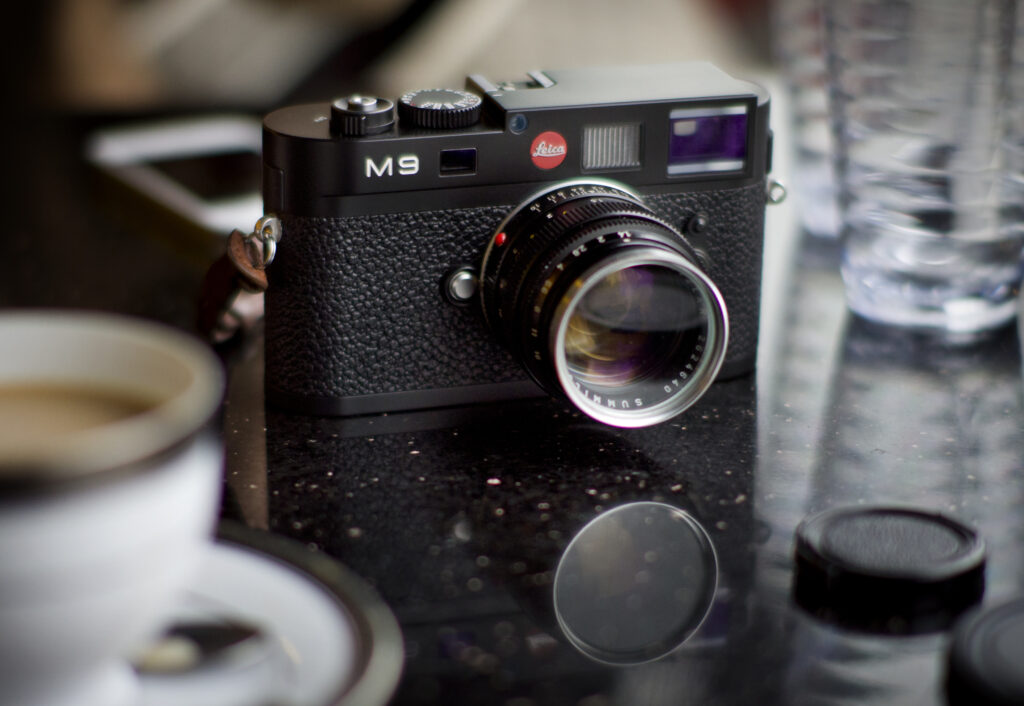
In an era dominated by mirrorless marvels and computational photography, the Leica M9 (2009) remains a cult icon—a camera that defies obsolescence.
As we navigate 2025, this digital rangefinder continues to captivate photographers who crave tactile craftsmanship, timeless design, and a sensor that renders colors like no other.
Whether you’re a collector, a street shooter, or a film convert seeking digital simplicity, the M9’s allure is undeniable. Let’s explore why this “digital classic” still belongs in your kit.
Why the Leica M9 Still Matters
The Leica M9 isn’t just a camera; it’s a statement. As the first full-frame digital rangefinder, it bridged Leica’s storied film heritage with the digital age. In 2025, its appeal lies in three pillars:
- Uncompromising Design: The brass-and-magnesium body, manual focus rangefinder, and minimalist controls evoke a pre-touchscreen era. For photographers who value process over convenience, the M9 demands intentionality.
- CCD Magic: Its 18MP CCD sensor (a rarity since CMOS dominance) delivers a film-like tonal gradation and “Leica glow” that modern sensors struggle to replicate.
- Nostalgia Meets Permanence: With no video mode, flippable screen, or AI autofocus, the M9 strips photography back to essentials—light, composition, and moment.
The Magic of the CCD Sensor: Why Colors Still Pop
The Kodak KAF-18500 CCD sensor is the M9’s soul. Unlike CMOS sensors optimized for speed and dynamic range, the CCD prioritizes color depth and organic contrast.
- Legendary Color Rendering: Skin tones feel lifelike, greens mimic Velvia film, and blues retain a velvety richness. Photographers praise its “Leica M9 color science” for portraits and landscapes.
- Low ISO Mastery: At ISO 160–800, images glow with a crisp, almost 3D dimensionality. Beyond ISO 2500, noise creeps in—a tradeoff for that analog texture.
Pro Tip: Shoot in DNG (RAW) to maximize editing flexibility, especially for recovering highlights.
Leica M9 Specs & Shooting Experience: Less Tech, More Soul
Key Specs:
- 18MP full-frame CCD sensor
- Leica M-mount compatibility (works with lenses from 1954–today)
- 2.5″ LCD (low-res by 2025 standards)
- ISO 160–2500
- No video recording
Real-World Feel:
The M9 rewards patience. Manual focus via the rangefinder patch forces you to slow down. The shutter click is soft yet decisive, ideal for street photography. Battery life? Carry a spare. The screen is barely usable for critical review—embrace it as a modern “film camera” and trust your instincts.
For official specifications and legacy documentation, visit the Leica M9 product page (archived).
Real-World Use in 2025: Pros and Cons
Pros:
- Timeless Aesthetics: Images feel “human,” not clinically perfect.
- Durability: Built to outlive trends; many units still thrive after 15+ years.
- Investment Potential: Well-maintained M9s hold value, especially post-sensor replacement.
Cons:
- Low-Light Limits: Struggles in dim settings vs. CMOS-based Leica M10 or M11.
- Sensor Risks: Early models had corrosion issues—opt for units with replaced CCDs.
- No Video: A pro for purists, a dealbreaker for hybrid shooters.
Leica M9 vs Modern Alternatives: Which Wins?
| Feature | Leica M9 (2009) | Leica M10 (2017) |
|---|---|---|
| Sensor | 18MP CCD | 24MP CMOS |
| ISO Range | 160–2500 | 100–50,000 |
| Body Thickness | 37mm (classic M3 profile) | 33.75mm (slimmer) |
| Price (Used) | 2,500–2,500–4,000 | 5,000–5,000–6,500 |
Verdict: The M10 offers modern conveniences (better ISO, quieter shutter), but the M9 wins on character and cost. For collectors, the M9 is irreplaceable; for daily drivers, the M10’s CMOS is pragmatic.
Who Is the Leica M9 For?
- Street Photographers: Discreet, silent(ish), and lightning-fast with zone focusing.
- Collectors: A milestone in Leica’s digital evolution.
- Film Converts: Digital simplicity meets analog workflow.
Where to Buy the Leica M9 in 2025
Finding a Leica M9 for sale in 2025 isn’t easy. With its discontinued status, CCD cult following, and known sensor recall history, clean examples with a replaced sensor are becoming increasingly rare—and expensive.
Check reputable resellers like KEH, MPB, and B&H’s used gear sections frequently. You can also set alerts on eBay for listings that include a documented sensor replacement or recent CLA (clean-lube-adjustment). But be prepared: well-maintained M9s tend to sell quickly and rarely reappear in volume.
Can’t find a Leica M9? You’re not alone. Inventory is scarce—but the Leica M10 captures the M9’s classic rangefinder experience with modern reliability, enhanced ergonomics, and improved ISO performance. It’s a worthy successor that preserves the magic while solving many of the M9’s long-term issues.
Always Verify: Ask for proof of sensor replacement (Leica’s “CCD Warranty” ended in 2016, but serviced models exist).
People Also Ask
Final Thoughts: A Digital Classic
In a world where cameras chase specs, the Leica M9 reminds us that gear can be art. It’s not for everyone—its quirks demand adaptation. But for those who embrace it, the M9 becomes an extension of creative vision. As Ansel Adams said, “The single most important component of a camera is the twelve inches behind it.” The M9 sharpens those inches, grounding us in photography’s essence.
Is the M9 right for you? If you value legacy over luxury and soul over speed, the answer is yes.
